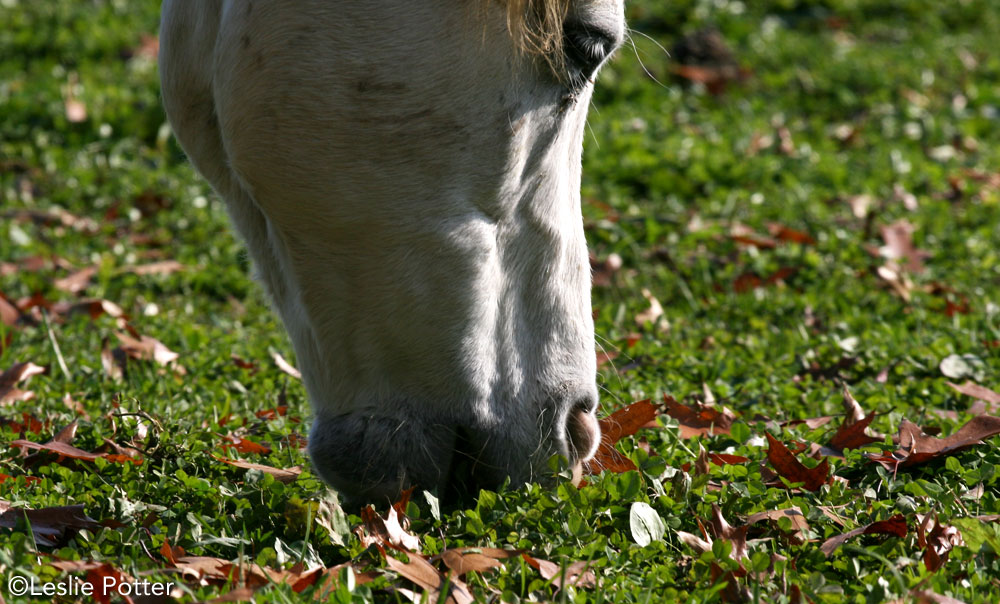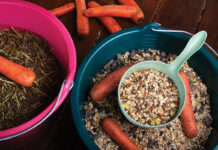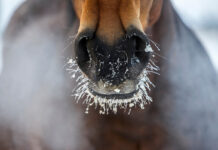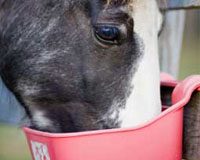
But how can you be so sure that the grass is unsafe? You can’t. That is, you can only guess, unless you have it analyzed for its level of non-structural carbohydrates (NSC), which include sugars, starch, and fructans. Insulin resistant horses (ones suffering from equine metabolic syndrome or Cushing’s disease) as well as horses with polysaccharide storage myopathy (PSSM) should not consume large amounts of sugar and starch. Fructans are mainly digested by the hindgut bacteria, so while they do not significantly contribute to an insulin surge, they can cause laminitis when too much is fermented, potentially leading to cecal acidosis and endotoxin release into the bloodstream.
Here are the guidelines during the fall:
- When the daytime temperatures are relatively warm, and especially when it’s sunny, the grass produces sugar and starch via photosynthesis. The grass would normally burn up these carbohydrates during the night, making the morning the safest time to let your horse graze. BUT when it gets cold, the grass doesn’t readily do that. Instead it may hold on to the sugar/starch, remaining concentrated in the morning; therefore, it is likely not safe to allow your insulin resistant horse to graze on pasture when it has been cold the night before. What I mean by “cold” is below 40 degrees F most of the night.
- Not all grasses, however, react the same way to cold temperatures. Cool season grasses such as timothy, brome, orchard grass, Kentucky bluegrass, and fescue tend to continue growing during cooler months. Coastal Bermuda, buffalo grass, Teff and other Bermuda-related strains tend to go dormant as soon as fall hits. You’ll notice the grass turning brown, but be careful – spread the blades apart; if there is green at the base, there is still growth that can contain a lot of sugar and starch. If it’s brown clear down to the base, it is likely safe to feed.
- If there is frost on the grass in the morning, it is too risky to let your insulin resistant horse graze.
- If the grass has been stressed due to drought or overgrazing, the grass may be high in sugar/starch.
Once the night temperatures consistently fall below freezing, you can expect that the grass is dormant and is safe to feed. However, it is still a good idea to test your pasture, even during a dormant state.
It is easy to do
Suitable labs can be found at local vet schools or county extension services. Equi-Analytical Labs is a good choice because they provide you with numbers that relate to horses, not cattle. The instructions are not complicated and can be found on their website: www.equi-analytical.com. Basically, you randomly select about 15 sites throughout your pasture, cutting only to the grazing height. For example, if an ungrazed area is 10 inches high, and your horse only eats the top 4 inches, cut samples that are four inches from the top. Chop into small strips, stuff in the provided bag, freeze overnight, and mail it in. On the order form, choose their “Fast Track” test for carbohydrate levels or their “Equi-Tech” test if you’d also like to know the mineral content.
Pasture Testing Glossary
Once you have your lab report, but before you do any calculations, it is best to know some key terms:
- Percent Moisture and Dry Matter: these numbers add to 100%. Notice that since pasture is mostly water, the moisture percentage will be very high.
- As Sampled column: these numbers describe the grass with its water content.
- Dry matter column: these values are more concentrated because they describe the forage without any water.
- Digestible energy (DE): number of mega calories (Mcals) per lb or kg of hay.
- Water soluble carbohydrates (WSC): simple sugars plus fructans. Fructans do not accumulate in warm-season grasses or alfalfa.
- Ethanol soluble carbohydrates (ESC): simple sugars.
- Starch: long strands of glucose (simple sugar) linked together that are digested down to individual glucose molecules.
- Non-structural carbohydrates (NSC): this will not be on the report. It is calculated as WSC+Starch.
Before you begin calculations, it is helpful to make your pasture comparable to hay.
We typically look for hay that has less than 12% NSC on an as-sampled basis, but now we’re dealing with forage. You can look strictly at the numbers under the “dry matter” column. Or you can make these numbers more comparable to what you’d find in the average hay. Though hay can vary in its moisture content, its average dry matter concentration is 93%. Therefore, the first step is to multiply the numbers in the “dry matter” column by 0.93.
Good Grazing Indicators
Your grass should ideally have the following parameters, on a “hay-comparable” basis, to be considered safe:
- DE should be less than 0.88 Mcals/lb (1.94 Mcals/kg) if your horse is overweight.
- NSC should be less than 12%.
- ESC + Starch should be less than 10%.
Sometimes the NSC level is above 12% but the ESC + Starch is less than 10%. Look at this example:
WSC = 14%
ESC = 6%
Starch = 2%
The NSC = 14 + 2 = 16%. This would normally be considered too high. However, the ESC + Starch is only 8%. In this case, you can feel comfortable feeding it. The difference between WSC and ESC is mostly from fructans. But if their concentration is too high, there is the potential for hindgut acidosis. If the NSC in this example had been upwards of 20%, even with a low ESC + Starch content, it would be too risky to feed.
When to Test Your Pasture
During the fall: Pay attention to the time of day and weather conditions when you take your samples. Try to test on a sunny day when the day before was also sunny.
It is best to take two samples on the same day:
- In the morning before 8:00 am (best case scenario)
- In the late afternoon after the grass has been exposed to sunlight (worst case scenario)
During the winter: Once the night temperatures stay consistently below freezing, the grass will stop growing. Test in the morning and late afternoon, to see if it is safe for your horse to graze.
Example Pasture Analysis
The analysis results below represent an actual pasture sample. To utilize these numbers, first calculate “hay-comparable” values (each dry matter value is multiplied by 0.93):
Sample Pasture Analysis | |||
| As Sampled (%) | Dry Matter (%) | Hay-Comparable (%) | |
| WSC (Water Soluble Carbohydrates) | 4.9 | 11.3 | 10.51 |
| ESC (Simple Sugars) | 3.7 | 8.5 | 7.91 |
| Starch | 0.1 | 0.2 | 0.19 |
| NSC (WSC + Starch) | 11.5 | 10.70 | |
| ESC + Starch | 8.7 | 8.10 | |
This particular pasture was tested in North Dakota during October when the night temperatures dipped below 40 degrees F for several hours, followed by sunny days. The sample was taken in the morning. Notice that the NSC is excellent – less than 12% (which was unexpected). Furthermore the sum of ESC + Starch is less than 10%. This pasture is safe for the insulin resistant horse and the owners can feel comfortable allowing their horses to graze during the morning hours. In order to know if it is safe for afternoon grazing another sample should be obtained.
Summary
Pasture testing may need to be done several times throughout the season to see how the grass behaves under varying circumstances. You may be pleasantly surprised, which would make your horses happy and give you peace of mind. During times when your pasture is not appropriate, move your horse to a dry area and provide hay (which you have also tested) free-choice, available all day and all night.
Juliet M. Getty, Ph.D. is an internationally respected, independent equine nutritionist who believes that optimizing horse health comes from understanding how the horse’s physiology and instincts determine the correct feeding and nutrition practices. Visit www.gettyequinenutrition.com to sign up for her informative, free monthly newsletter, Forage for Thought; browse her library of reference articles; search her nutrition forum; and purchase recordings of her informative teleseminars.







Lots of great information, that I will not understand it all in just one reading. But, I was wondering, if like me, I have no other choice, except to let the horses out to pasture each morning. I only have enough hay for Dec-May, and if I feed earlier, I will run short.
coool
great info
cool
I am beginning to think I need to “bubble wrap” my horses,
Wow, so complicated. At least I can remember the basic idea.